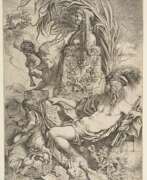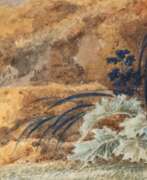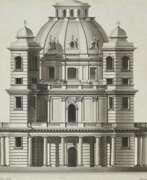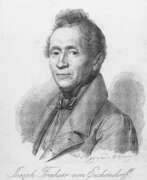Europe 18th century
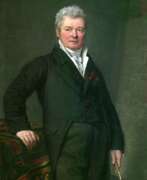

Fyodor Yakovlevich Alekseyev (Russian: Фёдор Яковлевич Алексеев) was a Russian painter born around 1753 in Saint Petersburg. Known as the "Russian Canaletto" for his masterful vedute, or detailed paintings of cityscapes, Alekseyev made significant contributions to Russian art, particularly in depicting urban landscapes.
Alekseyev was admitted to the Imperial Academy of Arts in 1764, where he initially studied ornamental sculpture and scenic painting under Antonio Peresinotti. He spent several years in Venice, funded by a fellowship, where he studied theater painting but preferred creating landscapes and copying works by old masters. Upon his return to Russia, he faced restrictions but gradually gained recognition for his independent work. His notable painting "View of the Palace Embankment from the Fortress" earned him the title of Academician in 1794.
In 1800, Tsar Paul I commissioned Alekseyev to paint the streets and architecture of Moscow, resulting in numerous significant works that highlighted the city's grandeur. Despite a decline in fame later in life, his contributions to Russian urbanscape painting remain influential, with works such as "Red Square" and "The Flood of 1824 in the square at the Bolshoi Kamenny Theatre" held in major Russian museums like the State Russian Museum and the Tretyakov Gallery.
For updates on sales and auction events related to Fyodor Yakovlevich Alekseyev, sign up for our newsletter.
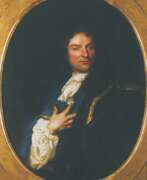

Filippo Abbiati was an Italian painter, renowned for his contribution to the Baroque period. Born in Milan in 1640, Abbiati's training under Carlo Francesco Nuvolone and Antonio Busca honed his skills, leading him to develop a distinct style characterized by fluid touch and luminous foundations. His work was heavily influenced by early seventeenth-century Lombard painting and later, the Roman Baroque and Venetian painting.
Abbiati's career was predominantly based in Milan, where he produced numerous significant religious and historical paintings. Notable works include the altarpiece of the Preaching of St. John the Baptist for the Sanctuary of the Beata Vergine dei Miracoli in Saronno and the extensive frescoes in the Milanese church of Sant'Alessandro. His masterpieces are celebrated for their dynamic composition and expressive intensity, marking a transition toward the Rococo movement.
Though details about his later years remain sparse, Abbiati's legacy lives on through his influential frescoes and the mentorship of notable students like Alessandro Magnasco. His works can still be admired in places like the Pinacoteca di Brera in Milan and the Biblioteca Ambrosiana.
For collectors and enthusiasts looking to explore the depth of Italian Baroque, Filippo Abbiati's work offers a rich narrative woven through the tapestry of art history. Sign up for updates on auctions and new discoveries related to Filippo Abbiati, ensuring you stay informed about opportunities to own a piece of this illustrious artist's legacy.
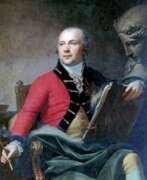

Ivan Akimovich Akimov (Russian: Иван Акимович Акимов) was a Russian painter celebrated for his contributions to the Classical and Neoclassical styles of art. Born into a family of a typographer for the Governing Senate, Akimov's journey into the arts began early when, after his father's death, he penned a heartfelt letter to the Imperial Academy of Arts. This letter secured his admission, marking the start of his lifelong association with the Academy, where he evolved from a student to its director.
Akimov's education at the Academy was marked by numerous awards, including gold medals for his artworks, showcasing his burgeoning talent in painting. His artistic journey took him to Italy on a fellowship, where, despite initial challenges, he found mentorship under Pompeo Battoni and was inspired by the Venetian masters. This period was instrumental in shaping his skills and artistic outlook.
Throughout his career, Akimov was revered not just for his artistic output but also for his contributions to art education and historiography in Russia. He played a pivotal role at the St. Petersburg Academy of Arts, ultimately serving as its director. Akimov's legacy extends beyond his paintings, through his influence on future generations of artists and his foundational work in Russian art historiography. Among his notable works are "Prometheus Making a Statue at the Command of Minerva" and "The Baptism of Princess Olga in Constantinople", which reflect his classical influences and historical interests.
For those interested in exploring Ivan Akimovich Akimov's works and legacy, signing up for updates on new product sales and auction events related to Akimov could provide valuable insights and opportunities to connect with his art. This subscription ensures you stay informed about the latest discoveries and offerings in the world of Russian classical painting.
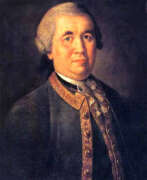

Alexei Petrovich Antropov (Russian: Алексей Петрович Антропов), a prominent Russian painter of the Baroque period, is celebrated for his significant contributions to art, particularly in portrait painting and church frescoing. Born into a family connected to the governmental sphere, Antropov's early exposure to the arts came through his work in the Chancellory of Buildings, where he began his career under the guidance of various Russian and foreign artists, including Andrey Matveyev and Ivan Vishnyakov.
Antropov's work is distinguished by his mastery in oil painting, miniatures, and icons, with a career that saw him active mainly in St. Petersburg, Moscow, and Kiev. His artistic journey was notably influenced by his studies with the French court painter Louis Caravaque and later with the Italian painter Pietro Rotari, which helped him refine his portrait artistry. The 1760s emerged as his most productive period, where he crafted numerous notable portraits, including those of Elizabeth Petrovna and Peter III of Russia, showcasing his preference for traditional icon and parsuna portrait styles characterized by sharp contrasts and dark backgrounds.
Antropov's legacy extends beyond his artworks; his dedication to art education and the community is evident in his decision to transfer his only house to the Department of Education for the establishment of a Free School. He passed away in 1795, leaving behind a rich collection of works that continue to be celebrated in museums such as the Tretyakov Gallery in Moscow and the Russian Museum in St. Petersburg.
Collectors and art experts value Antropov for his unique contributions to Russian art, his role in the transition of portrait styles, and his influence on future generations of artists, including his apprentice Dmitry Levitzky. His works, including the portraits of Catherine II and Archbishop Gavriil Petrov, are pivotal in understanding the artistic and cultural shifts of 18th-century Russia.
For those interested in exploring the depths of Russian Baroque art and the significant figures who shaped its contours, Alexei Petrovich Antropov's oeuvre offers a fascinating journey. Collectors and aficionados are encouraged to sign up for updates on new product sales and auction events related to Antropov's works, ensuring they remain informed about opportunities to own a piece of this illustrious artist's legacy. This subscription is a gateway to the vibrant world of art collection, where the beauty of the past is preserved for the future.
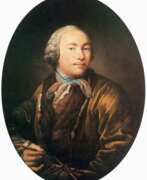

Ivan Petrovich Argunov (Russian: Иван Петрович Аргунов) was a distinguished Russian painter of the 18th century, celebrated for his significant contribution to portrait art. As a serf born into the Argunov family, who were established artists themselves, Ivan's talent was nurtured and supported by his patrons, leading to a unique position within the cultural and artistic hierarchies of his time. His specialization in portraiture allowed him to capture the essence of Russia's social elites, including members of the imperial family, as well as ordinary Russians, thereby providing a wide-ranging visual documentation of the era's societal strata.
Argunov's art is noted for its meticulous attention to detail, vibrant realism, and the emotional depth he brought to his subjects. His portraits are more than mere representations; they are intimate glimpses into the lives and characters of his sitters. Among his most famous works is the portrait of Princess Natalia Petrovna Golitsyna, showcased in the Tretyakov Gallery in Moscow. This particular piece stands out for its intricate portrayal of fabric textures and the detailed rendering of facial expressions, which have been lauded for their lifelike quality and depth.
Argunov's legacy extends beyond his artistic achievements; he played a pivotal role in shaping the course of Russian portraiture. His works are preserved in major museums and galleries across Russia, serving as a testament to his skill and the cultural richness of his time. For collectors and experts in art and antiques, Argunov's paintings are not just historical artifacts but are cherished for their aesthetic value and the insight they offer into 18th-century Russian culture.
We invite enthusiasts and collectors to stay connected with us for updates on new product sales and auction events related to Ivan Petrovich Argunov. By signing up, you will gain exclusive access to the finest pieces of Russian art and antiques, ensuring you never miss an opportunity to enrich your collection with works by one of Russia's most esteemed artists.
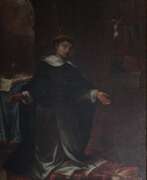

Benito Rodríguez Blanes was a Spanish Baroque painter and Catholic priest, celebrated for his contributions to the Granada School of art. Born in Granada and living through the 17th and early 18th centuries, Blanes became an influential figure in Spanish Baroque painting. He is noted for being a follower of Alonso Cano, a prominent painter of the time.
Blanes' artistic work, deeply rooted in religious themes, is distinguished by its spiritual depth and intricate detail. His works include beautiful paintings of the Virgin Mary, which were once located in the staircase of the archbishop's palace, and the sacristy of the Discalced Carmelites in Granada. Particularly notable are his paintings at the Museo de Bellas Artes de Granada, including a revered depiction of a Dominican saint.
For art collectors and experts, Blanes' works remain a testament to the rich cultural and artistic heritage of the Granada School. His paintings offer a glimpse into the spiritual and artistic expressions of his era.
To stay informed about new product sales and auction events related to Benito Rodríguez Blanes, sign up for our updates. This subscription is a must for enthusiasts and collectors interested in the pivotal figures of Baroque art and the Granada School.
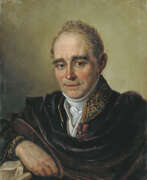

Vladimir Lukich Borovikovsky (Russian: Влади́мир Луки́ч Боровико́вский), a distinguished Russian artist of Ukrainian Cossack origin, was renowned for his mastery in portrait painting and ecclesiastical art. Born in Mirgorod, now Myrhorod, Ukraine, in 1757, Borovikovsky lived in Ukraine until the age of 31 before moving to St. Petersburg. His journey into the art world began under unusual circumstances when Empress Catherine II was impressed by his allegorical paintings, leading him to relocate to Saint Petersburg and adopt the more aristocratic surname Borovikovsky.
Borovikovsky's work epitomizes the sentimentalism era, capturing the essence and inner beauty of his subjects with a unique sensitivity and elegance. His ability to convey the nuanced emotions and dignified personalities of his sitters through intimate and detailed portraiture earned him acclaim, particularly among the Russian imperial family and nobility. Throughout his career, he produced about 500 portraits, with 400 surviving today, including notable figures such as Catherine II, Paul I, and Alexander Kurakin, as well as the celebrated "Portrait of M.I. Lopukhina".
In his later years, Borovikovsky's focus shifted towards religious painting, contributing significantly to the Kazan Cathedral and other ecclesiastical sites in St. Petersburg. Despite facing challenges, including court intrigues and a personal struggle with mental discord and alcohol, he left a lasting legacy through his art, which remains highly regarded for its depth, sincerity, and technical skill.
Collectors and experts in art and antiques cherish Borovikovsky's work for its historical significance and profound emotional resonance. His paintings, a fusion of classicist and sentimental styles, continue to inspire and captivate audiences, preserving the legacy of one of Russia's most gifted portraitists.
For updates on exhibitions and auction events featuring Vladimir Lukich Borovikovsky's work, sign up for our newsletter. Stay informed about the latest discoveries and opportunities to add a piece of history to your collection.
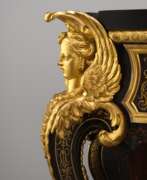

André-Charles Boulle, a French artist and cabinetmaker, was celebrated for his mastery in marquetry, a decorative technique involving inlaid veneers of wood, metal, and tortoiseshell. Born in Paris in 1642, Boulle's work defined luxury and sophistication in 17th and 18th-century French furniture, earning him the title of "Premier ébéniste du Roi" under Louis XIV. His contributions to art and culture extend beyond mere craftsmanship, embodying the opulence of the Louis XIV style and influencing European decorative arts profoundly.
Boulle's innovative techniques, particularly his unique use of marquetry, known as "Boulle work," involved intricate patterns of brass, pewter, and tortoiseshell, setting new standards for furniture design. This approach allowed him to create stunning visual effects, with his creations including clocks, cabinets, and tables that showcased both artistic flair and technical brilliance. His work, characterized by elaborate motifs and an exceptional blend of materials, is regarded as the epitome of Baroque artistry, blending sculpture, painting, and architecture into functional objects of beauty.
Several of Boulle's masterpieces are preserved in prestigious museums, such as the Louvre and the Palace of Versailles, where they continue to captivate visitors with their intricate details and historical significance. Notable works attributed to him, like the intricate coffers on stands and monumental cabinets housed in the J. Paul Getty Museum, reflect his role as a "painter in wood," celebrating French military victories and the grandeur of the Sun King's court. These pieces, never signed but attributed to him based on stylistic elements and historical records, highlight Boulle's innovative use of materials and his impact on the decorative arts.
For collectors and experts in art and antiques, André-Charles Boulle's work represents the zenith of French decorative arts. His legacy is not only in the beauty of his creations but also in the techniques he perfected, which continue to inspire contemporary designers and craftsmen. Those interested in the elegance and history of Boulle's work are encouraged to sign up for updates on new product sales and auction events related to this iconic artist. This subscription offers a unique opportunity to connect with the world of André-Charles Boulle, ensuring enthusiasts are informed of the latest discoveries and offerings that celebrate his enduring influence on culture, art, and design.
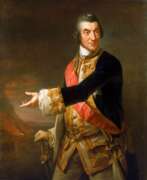

Richard Brompton was an esteemed English portrait painter, active during the mid to late 18th century. Born around 1734, Brompton honed his artistic skills under the mentorship of Benjamin Wilson and later, in Italy, with Raphael Mengs. His Italian sojourn also brought him under the patronage of the Earl of Northampton, leading to significant exposure and subsequent recognition back in England.
Brompton's mastery in portraiture gained him high-profile commissions and admittance to elite art circles, including the Presidency of the Society of Artists from 1779 to 1780. Some of his notable works include portraits of influential figures such as William Pitt, the 1st Earl of Chatham, and Admiral Sir Charles Saunders, which are preserved in prestigious locations like the National Maritime Museum and the National Portrait Gallery.
Later in his career, financial difficulties led him to St. Petersburg, Russia, where he served as the court painter to the Empress of Russia, enjoying considerable success before his death in 1783.
For those interested in the works and legacy of Richard Brompton, especially collectors and art experts, staying informed about upcoming auctions and exhibitions can be highly rewarding. To receive updates specifically about new product sales and auction events related to Richard Brompton, consider signing up. This subscription ensures you are well-informed of opportunities to acquire pieces linked to this distinguished artist.
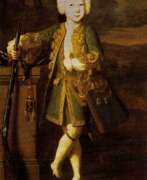

Louis Caravaque was a French portrait painter renowned for his contributions to Russian art during the early 18th century. Born in 1684 in Marseilles, France, Caravaque embarked on his artistic journey influenced by his family's background in decorative painting. His talent soon caught the attention of influential figures, leading to a pivotal contract in 1715 that took him to Russia. There, he famously painted Peter the Great and became a favored artist at the Russian court.
Caravaque's work is distinguished by his detailed and expressive portraiture, which earned him the position of the first court painter during Anna Ioannovna's reign. He played a significant role in the cultural exchanges between France and Russia, melding Western European techniques with Russian traditions. His notable works, which include portraits of Russian royalty and nobility, are held in prestigious collections such as the Hermitage and the Russian Museum in St. Petersburg.
Among his most celebrated paintings are the portraits of Peter the Great, Empress Elizabeth as an Olympic goddess, and Catherine II, showcasing his skill in capturing the grandeur and intricacy of his subjects. These artworks not only highlight his mastery of oil painting but also reflect the rich historical and cultural milieu of his time.
For collectors and art experts, the legacy of Louis Caravaque offers a fascinating glimpse into the intersection of French artistic influence and Russian imperial identity. His works remain a testament to his skill and the cultural bridge he helped forge between two distinct worlds.
For more information and to stay updated on exhibitions featuring Louis Caravaque’s work, consider signing up for updates related to this remarkable artist.
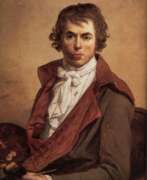

Jacques-Louis David, a preeminent French artist of the Neoclassical movement, made a profound impact on the art world with his compelling history paintings and portraiture. Born in Paris in 1748 into a prosperous family, David's early life was marked by tragedy and ambition. Despite losing his father at a young age and facing opposition from his family, his determination to pursue art led him to become a student of Joseph-Marie Vien and later, a notable figure in the French Academy in Rome. David's artistic journey was characterized by a rigorous classical education, culminating in winning the prestigious Prix de Rome in 1774, which allowed him to study the masterpieces of classical antiquity and the Renaissance in Italy.
David's work is renowned for its classical austerity, a response to the frivolous Rococo style that preceded him. His paintings, such as "The Oath of the Horatii," reflect a blend of classical themes with a modern sense of emotion and drama, resonating with the revolutionary spirit of his times. As the French Revolution unfolded, David aligned himself with its ideals, becoming an active supporter and using his art to serve political purposes. He was closely associated with leaders of the Revolution, including Maximilien Robespierre, and later became the official painter of Napoleon, contributing significantly to the iconography of the era.
Throughout his career, David had a significant influence on French art, not only through his own works but also as a teacher. His studio was a nurturing ground for the next generation of French painters, despite his reputation for being demanding. David's move to Brussels after the fall of Napoleon marked the final phase of his career, where he continued to paint until his death in 1825.
David's legacy extends beyond his contributions to Neoclassical art. He played a crucial role in the development of modern art history, blending classical ideals with contemporary themes, and influencing not only his contemporaries but also future generations of artists. His works, housed in museums around the world, continue to be studied and admired for their technical mastery and emotional depth.
For art collectors and experts, David's oeuvre offers a fascinating insight into a transformative period in art history, where the classical and the contemporary intersected to create a new visual language. His paintings not only depict historical and mythological scenes but also embody the ideals, struggles, and aspirations of his time.
For those interested in exploring the works of Jacques-Louis David and the impact of his art on the Neoclassical movement, updates on new product sales and auction events related to David's work can provide valuable opportunities to engage with his legacy. Signing up for updates ensures access to the latest information and events, offering a deeper understanding of this pivotal artist's contributions to art and culture.
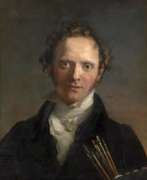

George Dawe was an English portrait artist, celebrated for his depictions of Russian military leaders. Born in 1781 in London, Dawe was a prodigy in engraving under his father's tutelage before shifting his focus to painting. He gained recognition at the Royal Academy of Arts and became a member in 1814.
Dawe's career reached international prominence when he moved to Saint Petersburg in 1819, following a commission from Tsar Alexander I. There, he created over 300 portraits for the Military Gallery at the Winter Palace, capturing the visages of Russia's elite during Napoleon's invasion. His works, praised for their historical value and artistic merit, are still displayed in the Hermitage Museum today.
Despite his death in 1829, Dawe's legacy persists, particularly in Russia, where he is regarded as a key figure in military portraiture. His works remain a significant part of cultural exhibitions and continue to attract scholars and art enthusiasts.
If you're fascinated by the rich history of art and the stories behind iconic portraits, consider signing up for updates on George Dawe. Stay informed about new sales and auction events that feature his masterful works. Your subscription will keep you connected to the world of historical art and its vibrant market.
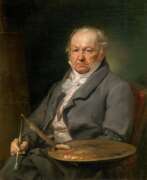

Francisco José de Goya y Lucientes was a Spanish romantic painter and printmaker, celebrated as the most pivotal Spanish artist of the late 18th and early 19th centuries. Born in Fuendetodos, Aragon, Spain, on March 30, 1746, Goya's work reflects a tumultuous period of history, intertwining the personal, political, and social upheavals of his time with a bold and innovative artistic vision. His early career was marked by portraits of the Spanish aristocracy and royalty, as well as Rococo style tapestry cartoons for the royal palace. However, following a severe illness in 1793 that left him deaf, his art took on a darker and more pessimistic tone.
Goya's oeuvre is vast, encompassing around 700 paintings, 280 prints, and several thousand drawings, through which he depicted a wide range of subjects from the whimsical to the macabre. Notable among his works are "The Naked Maja," "The Clothed Maja," "The Family of Charles IV," "The Third of May 1808: The Execution of the Defenders of Madrid," and "Saturn Eating His Children." His etchings, particularly the series "Los Caprichos" and "The Disasters of War," are celebrated for their intricate detail, emotional depth, and critical social commentary.
Goya's contribution to art goes beyond his mastery of painting and printmaking. He is often considered the bridge between the Old Masters and modern art, introducing themes and techniques that would influence countless artists in the centuries to follow. His ability to capture the essence of his era, the human condition, and the complexities of his own psyche, makes his work universally relatable and enduringly relevant.
His most famous paintings are housed in prestigious museums worldwide, including the Museo del Prado in Madrid, which holds an extensive collection of his works. The Prado's collection serves as a testament to Goya's significant impact on art and culture, offering insight into the artist's unique perspective on the world around him.
For collectors and experts in art and antiques, Francisco de Goya's legacy is a beacon of artistic innovation and historical significance. His works not only adorn the walls of museums but also continue to inspire and provoke thought among audiences across the globe.
For updates related to Francisco de Goya, including new product sales and auction events related to his works, sign up for our newsletter. Stay informed on the latest offerings and opportunities to add to your collection of this legendary artist's works.
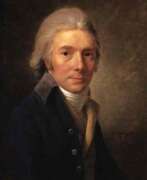

Jean Balthasar de la Traverse was a French painter and actor who worked in Russia during the 18th century. Born in 1752, he arrived in Saint Petersburg in 1773, joining a theatrical troupe and becoming a painter. He was patronized by Count Alexander Stroganov, for whom he created an album depicting views of Russian Empire cities.
De la Traverse is also known for his battle scenes from the Russo-Turkish War. His work, including landscapes and watercolors, was highly esteemed by contemporaries. The last records of him date to 1808.
Jean Balthasar de la Traverse's art continues to intrigue collectors and art historians. His mastery in depicting nature and historical events makes him a significant figure in art history. Subscribe for updates on new sales and auctions related to his works.
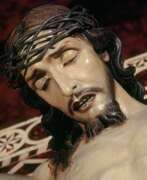

Jose de Mora was a Spanish sculptor renowned for his contributions to Baroque art. Born in Baza in 1642, Mora was the eldest son of sculptor Bernardo de Mora and notably a pupil of Alonso Cano. His career was distinguished early on when he moved to Madrid in 1669, two years after Cano's death, to work with Sebastián de Herrera Barnuevo, another of Cano's pupils. Mora's reputation was further solidified in 1672 when he became a sculptor for King Charles II, highlighting his significance in the Spanish royal court.
Mora's work is celebrated for its expressive minimalism and austere style, a deviation from his mentor Cano's approach, yet achieving a distinct artistic effectiveness. His sculptures, particularly those of religious figures, are characterized by a unique blend of realism and emotion, making them profound objects of devotion. Notable works include the Christ of Mercy and Our Lady of Sorrows in Granada, among others found in the cities of Jaén, Seville, Valladolid, and Córdoba.
One of Mora's masterpieces, the Virgin of Sorrows, is held in high esteem for its technical virtuosity. This painted pinewood bust, adorned with ivory and glass to achieve lifelike details, exemplifies Mora's skill in using realistic details to evoke emotional resonance. This piece, among others, underscores Mora's contribution to Spanish Baroque sculpture and his ability to convey intense emotion through his art.
Mora's legacy is preserved in various collections, including the Victoria and Albert Museum, which houses his bust of the Virgin of Sorrows. His works continue to be a focal point for scholars and enthusiasts of Baroque art, as seen in exhibitions and the digital archives of Wikimedia Commons, offering insight into his contributions to the art world.
For art collectors and experts seeking to delve deeper into the works of Jose de Mora, signing up for updates on new sales and auction events can offer exclusive access to acquiring pieces by this eminent sculptor. This subscription will ensure that enthusiasts are well-informed about opportunities to own a part of Spanish Baroque history.
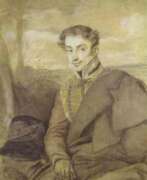

Alexander Ivanovich Dmitriev-Mamonov (Russian: Александр Иванович Дмитриев-Мамонов) was a Russian military commander and battle painter, known for his significant contributions both in the military and in the arts. Born on December 24, 1787, in Saint Petersburg, he was the son of Major-General Ivan Dmitriev-Mamonov. His early career saw him serving as an actuary at the Collegium of Foreign Affairs and later at the State Chancellery.
Dmitriev-Mamonov joined the People's Militia in 1812, rising to the rank of Lieutenant and participating in key battles such as Borodino and Krasnoi during the Napoleonic Wars. By 1823, he was promoted to Colonel and subsequently to Major-General in 1831, commanding various cavalry regiments. Apart from his military endeavors, Dmitriev-Mamonov was also an accomplished amateur artist. He co-founded the Imperial Society for the Encouragement of the Arts and established a drawing school in 1827. His battle sketches and watercolors are prominently displayed in Tsarskoye Selo.
In 1835, he transitioned to civil service, becoming a State Councillor at the Ministry of Internal Affairs. His notable awards include the Order of Saint Vladimir, Order of Saint Anna, and the Medal "For the Capture of Paris." Dmitriev-Mamonov's legacy is preserved through his artistic works and his contributions to Russian military history.
For more updates on auctions and sales related to Alexander Ivanovich Dmitriev-Mamonov's works, sign up for our newsletter to stay informed about new product sales and auction events.
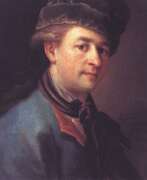

Pyotr Semyonovich Drozhdin (Russian: Пётр Семёнович Дрождин) was a Russian artist, renowned for his unique contributions to painting and sculpture. His work, characterized by its emotional depth and striking realism, has captivated art enthusiasts and collectors worldwide.
Drozhdin's art is a blend of classical Russian techniques with modernist twists, making each piece distinctly timeless yet contemporary. His paintings often depicted rural Russian life and landscapes, imbuing them with a sense of nostalgia and profound beauty. Meanwhile, his sculptures are noted for their intricate detailing and the ability to capture the human spirit.
His works are displayed in various prestigious galleries and museums, not only in Russia but around the globe. They continue to attract admiration for their craftsmanship and artistic integrity.
For those keen on exploring more about Pyotr Semyonovich Drozhdin or adding a piece of his legacy to their collections, staying updated on exhibitions and auction events is essential. Sign up for updates on sales and exhibitions featuring Drozhdin's works to ensure you never miss an opportunity to own a piece of Russian art history.
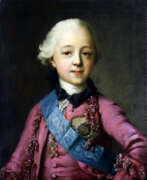

Vigilius Eriksen was a Danish portrait painter, celebrated for his deft representation of royalty during the 18th century. Born in Copenhagen on September 2, 1722, Eriksen gained early acclaim but faced setbacks such as being denied entry to the Royal Danish Academy of Fine Arts despite winning a gold medal there in 1755. His fortune changed when he moved to Russia, becoming a court painter to Empress Catherine the Great. This period marked his most prolific phase, where he created iconic portraits that were not only artistic accomplishments but also potent symbols of Catherine’s authority and persona.
Eriksen’s works, like the grandiose portrait of Catherine II, showcased his skill in integrating elements of power and status, a testament to his subject's dominion and the high baroque style he employed. This painting, noted for its detailed depiction of regal attire and insignia, is held in high regard not just for its artistry but also for the insights it offers into the royal iconography of the time.
After his successful stint in Russia, Eriksen returned to Denmark, where he continued to work extensively for the royal family, leaving behind a legacy that includes works housed in major Danish collections such as Rosenborg Castle.
For those interested in exploring the works of Vigilius Eriksen or staying updated on exhibitions and auctions featuring his art, signing up for updates could be a valuable resource. This subscription will keep you informed about new sales and significant events concerning Eriksen’s artworks.
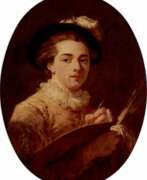

Jean-Honoré Fragonard, a prominent French Rococo painter, left an indelible mark on the art world with his vivacious and hedonistic approach to painting. Born in Grasse, France, in 1732, Fragonard's journey into the art world was marked by his early apprenticeship under François Boucher, whose influence is evident in the young artist's work. Fragonard's talent and skill were recognized early on when he won the prestigious Prix de Rome in 1752, which allowed him to study at the French Academy in Rome.
Jean-Honoré Fragonard's work is characterized by a remarkable facility, exuberance, and a penchant for themes of love and voluptuousness that resonated with the opulent and pleasure-seeking milieu of Louis XV's court. His paintings, such as "The Swing" (Wallace Collection), "Blind Man's Bluff," and "The Bolt," are celebrated for their tender beauty, vibrant color, and the virtuosity of his brushwork. These works encapsulate the essence of Rococo art with their playful themes, intricate compositions, and luminous palette.
Despite the initial success and the king's patronage, which saw his piece "Coresus et Callirhoe" being bought and reproduced at the Gobelins factory, Jean-Honoré Fragonard's career took a turn as the French Revolution upended the social order and the artist's private patrons were guillotined or exiled. This period forced Fragonard to leave Paris, seeking refuge in Grasse. He returned to the capital in the early 19th century, where he died in 1806, almost forgotten. It wasn't until the late 19th and early 20th centuries that Fragonard's work was re-evaluated, cementing his position among the masters of French painting. His influence on the Impressionists, particularly Renoir and his grandniece Berthe Morisot, is undeniable, showcasing his lasting impact on the trajectory of art history.
For collectors and experts in art and antiques, Jean-Honoré Fragonard's oeuvre represents the pinnacle of Rococo art, offering a glimpse into the opulent and sensuous world of 18th-century France. His paintings are not just artistic achievements but are also historical documents that reflect the cultural and social dynamics of his time.
To stay updated on new discoveries, sales, and auction events related to Jean-Honoré Fragonard's works, signing up for updates is recommended. This ensures that enthusiasts and collectors are promptly informed about opportunities to enrich their collections with the exquisite beauty of Fragonard's art.
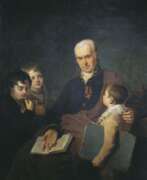

Kirill Ivanovich Golovachevsky (Russian: Кирилл Иванович Головачевский) was a Russian artist and graphic designer, best known for his role as an inspector at the Imperial Academy of Arts in St. Petersburg from 1771-1773 and 1783-1823. Born on May 27, 1735, in Korop, Russian Empire, he initially joined the Kiev Theological Academy but was later sent to St. Petersburg as a court chorister. Under the patronage of Empress Catherine II, Golovachevsky studied painting with Ivan Petrovich Argunov alongside his fellow choristers.
Though not considered a leading artist of his time, Golovachevsky contributed significantly to the Russian art scene through his portraits and historical paintings. His career at the Academy spanned over four decades, where he played a pivotal role in developing the institution's educational programs and nurturing the next generation of Russian artists.
Golovachevsky's works, such as the portrait of Elizabeth Sofie Albertine von Graevenitz, have been recognized in the art market, reflecting his skill in portrait art despite the criticisms of his contemporaries regarding his artistic abilities.
For collectors and art experts interested in Russian art and antiques, staying informed about updates and auction events related to Kirill Ivanovich Golovachevsky can provide valuable insights into this historical artist's contributions. Sign up for updates to ensure you don't miss out on new discoveries and sales related to his works.
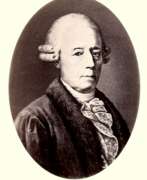

Georg Christoph Grooth was a German painter, renowned for his significant contributions to Russian art in the mid-18th century. Born in Stuttgart on January 21, 1716, Grooth moved to the Russian Empire in 1741, where he quickly became a favored portraitist at the Imperial Court under Empress Elizaveta Petrovna. His work during this period includes supervising and restoring royal painting collections and teaching Russian pupils, one of whom was the talented Ivan Argunov.
Grooth's most celebrated work is the 1743 equestrian portrait of Empress Elizabeth of Russia, which is preserved in the State Tretyakov Gallery in Moscow and has replicas in other major institutions like The Metropolitan Museum of Art. This iconic portrait shows Elizabeth in a green colonel's uniform, symbolizing her command over the Russian military and navy.
His role extended beyond painting; from December 1743, Grooth also served as the Keeper of the Palace art galleries, decorating interiors of palaces and other buildings in St. Petersburg and Tsarskoe Selo. This period marked a prolific phase where he created numerous portraits of the Russian aristocracy until his death on October 8, 1749, in St. Petersburg.
For collectors and experts in art and antiques, Grooth’s works offer a unique glimpse into the 18th-century Russian imperial court and its artistic preferences. Sign up for updates on new product sales and auction events featuring Georg Christoph Grooth’s work to enrich your collection with pieces of historical and artistic significance.


Johann Friedrich Grooth (Russian: Иван Фёдорович Гроот) was a German painter, celebrated for his exquisite animal paintings. Born in 1717 in Stuttgart, Grooth moved to St. Petersburg in 1743 where he would make his mark as a court painter to Empress Elizabeth Petrovna of Russia. His specialized talent in depicting animals with lifelike accuracy earned him high respect and prestigious commissions at the Russian court.
Grooth's artistry was particularly notable in his attention to detail, capturing the delicate features of bird feathers and animal fur. His works often portrayed scenes with animals and birds, rendered with such realism that they served not only as art but also as educational models in the Russian Academy of Arts, where he later taught.
Among his renowned works is "Two Toy Spaniels at a Sugar Bowl," painted in 1757, which exemplifies his skill in capturing the essence of his subjects. This painting, like many of his works, is celebrated for its intricate detail and vibrant life, capturing the spirit of the animals he painted so fondly.
For collectors and art enthusiasts interested in the unique blend of German artistry and Russian imperial history, Johann Friedrich Grooth's works are a testament to the rich cultural interplay of the 18th century. To stay updated on new acquisitions and auction events featuring Grooth's work, sign up for our newsletter.
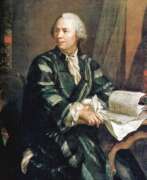

Georg Gsell was a Swiss Baroque painter, art consultant, and art dealer, renowned for his contributions to the arts during the early 18th century. Born in St. Gallen on January 28, 1673, Gsell's journey in the arts took him across Europe. He moved to Amsterdam in 1704, and later to Russia on the invitation of Peter the Great in 1716. In Russia, he served as the first curator of the Imperial art gallery, a significant cultural institution founded in 1720.
Gsell's work is appreciated for its meticulous detail and historical value. He catalogued the Kunstkamera, Russia's first museum, through detailed manuscript forms, a significant contribution to the preservation of early 18th-century European and Russian cultural artifacts. His artworks, which include portraits and still lifes, reflect the Baroque style's complexity and elegance.
For art collectors and experts, Georg Gsell's legacy offers a glimpse into the Baroque period's artistry and the early days of museum curation in Russia. His works and contributions remain subjects of study and admiration in art circles today.
For updates on exhibitions and sales related to Georg Gsell's works, sign up for our newsletter. This subscription will keep you informed about new findings and auction events specifically pertaining to Georg Gsell's art.
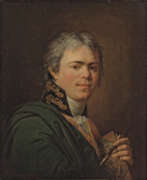

Andrey Ivanovich Ivanov (Russian: Андрей Иванович Иванов) was a distinguished Russian painter, renowned for his contributions to Neo-Classical art, particularly in historical scenes. Born in Moscow in 1775 and passing away in Saint Petersburg in 1848, Ivanov's journey in art was marked by his deep involvement with the Imperial Academy of Arts. From a young age, he demonstrated exceptional talent, receiving numerous accolades, including the prestigious Big Gold Medal from the Academy in 1797.
Ivanov's oeuvre is a testament to his mastery of historical and biblical narratives, capturing the essence of classical storytelling through his brush. Notable works such as "Prince Mstislav defeating Rededya" and "The Young Hero from Kiev" are just glimpses into his profound artistic legacy. His paintings not only reflect his technical skill but also his deep engagement with Russian history and mythology, contributing significantly to the cultural tapestry of his time.
Tragically, Ivanov's career faced challenges, particularly following his controversial painting "The Death of General Kulnev," which led to his removal from the Academy. Despite this setback, he continued to influence the art world, leaving a lasting legacy that includes his role as a teacher to prominent artists like Karl Briullov and his own son, Alexander Andreyevich Ivanov.
For art collectors and enthusiasts, Ivanov's work offers a rich exploration of Russian classicism, imbued with historical depth and artistic excellence. His paintings, preserved in museums and galleries, continue to inspire and captivate audiences, underscoring his enduring impact on the world of art.
For those keen on delving deeper into Ivanov's artistic journey and viewing his works, consider signing up for updates. This subscription will keep you informed about new product sales and auction events related to Andrey Ivanovich Ivanov, ensuring you stay connected to the legacy of this remarkable artist.
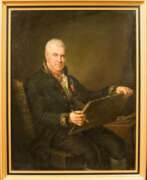

Mikhail Matveevich Ivanov (Russian: Михаил Матвеевич Иванов) was a Russian painter and watercolorist, born in 1748 in St. Petersburg. He is recognized for his landscape and battle scene paintings. Ivanov's early training was at the Imperial Academy of Arts, where he studied under Ivan Groot and later, Jean-Baptiste Le Prince in Paris. His works often depicted detailed landscapes and significant historical events.
Ivanov earned acclaim for his watercolors and drawings, many of which are housed in the State Russian Museum and the Hermitage Museum. Notable works include "View of Three Churches Against the Backdrop of Mount Ararat" and "Russian Fleet in the Bosphorus Strait".
Collectors and art enthusiasts highly regard Ivanov's contribution to Russian art, particularly his ability to capture the essence of the landscapes and historical moments of his time. To stay updated on new works and auction events related to Mikhail Matveevich Ivanov, sign up for our updates.
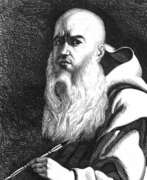

Joaquim Juncosa was a Spanish Baroque painter and Carthusian monk, whose work left an indelible mark on the art world. Born in 1631 in Cornudella, Tarragona, Juncosa's talent emerged early, nurtured in a family of painters. By 1660, he had joined the Carthusian monastery of Scala Dei, propelling his career and solidifying his reputation as a preeminent painter of the Catalan Baroque.
Juncosa's skill was not confined to a single genre; he was adept at both portraits and frescoes. His works, primarily commissioned by monasteries and private residences, reflected a distinct Baroque style tempered with a unique restraint. This style may have been influenced by his time in Rome and his exposure to Roman painting trends. Unfortunately, much of his work at Scala Dei was destroyed in the Ecclesiastical confiscations of Mendizábal in 1835 and the Spanish Civil War in 1936.
Despite these losses, Juncosa's legacy endures. His remaining works, including the twelve canvases of "Mysteries of the Rosary" at the Carthusian monastery in Valldemossa, Majorca, and pieces preserved at the Sant Jordi Fine Arts Academy and Museo del Prado in Madrid, continue to captivate art enthusiasts and experts alike. His ability to convey depth and emotion through his art makes him a celebrated figure in the world of Baroque painting.
For collectors and art and antiques experts, Joaquim Juncosa's works offer a glimpse into the rich tapestry of Spanish Baroque art. His paintings not only showcase his technical prowess but also provide an insight into the cultural and religious milieu of his time. To stay updated on new product sales and auction events related to Juncosa, sign up for our updates. Rest assured, our subscription is purely informational, focusing on bringing you the latest in the art world.


Yermolai Dementievich Kamezhenkov (Russian: Ермолай Дементьевич Камеженков) was an esteemed Russian artist, born in 1760 into serfdom in Tver. His early education in icon painting was under Dmitry Kryzhov, after which his talents brought him to St. Petersburg for further study with Gavriil Kozlov. Kamezhenkov's skills caught the attention of Catherine the Great, who, impressed by his work, emancipated him from serfdom in 1786.
Kamezhenkov's artistry was predominantly in portraiture, where he was noted for his subtle color harmonies and insightful character depiction. His works include notable portraits such as "Portrait of I. P. Groot" (1788) and "Portrait of an Unknown Man in a Purple Robe" (1790), which are held in high regard for their elegant color schemes and expressive depth. He became an Academician in 1794, an acknowledgment of his significant contributions to Russian art.
Living and working in cities like Moscow and Kashin, Kamezhenkov left a legacy that includes a rich collection of paintings, each preserving a piece of Russian history and culture through its vivid portrayal of its subjects. His works, such as the "Portrait of the Artist's Daughter with a Babysitter" (1808), are cherished not only for their artistic merit but also for their historical significance.
If you're intrigued by the story of Yermolai Dementievich Kamezhenkov and wish to explore more about his works and their impact on Russian art, consider signing up for updates on exhibitions and sales related to his works. This subscription is a great way to stay informed about special events and auction opportunities concerning Kamezhenkov's art.


Orest Adamovich Kiprensky (Russian: Орест Адамович Кипренский) emerged as a masterful Russian portraitist in the Age of Romanticism. His journey from an illegitimate serf background to a celebrated artist is a testament to his extraordinary talent and determination. Kiprensky's early exposure to art at the St. Petersburg Academy of Arts paved the way for his signature style, marked by emotional depth and technical brilliance.
Orest Kiprensky's works resonate with the spirit of Romanticism, capturing the essence of his subjects with remarkable sensitivity and nuance. His portrait of Alexander Pushkin is among his most famous, celebrated for its vivid portrayal of the poet's character. Kiprensky's life was as dramatic and varied as his art, with significant periods spent in Italy, where he immersed himself in the local culture and art scene, eventually marrying and converting to Roman Catholicism.
His legacy is enshrined in numerous galleries, where his portraits continue to captivate audiences with their expressive intensity and elegance. Orest Kiprensky's ability to capture the soul of his subjects on canvas ensures his enduring status as a pivotal figure in Russian Romantic art.
For those fascinated by Orest Kiprensky's life and work and keen on updates related to his art, including exhibitions and sales, subscribing to relevant updates can provide valuable insights into the world of this distinguished portraitist.
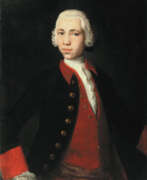

Mina Lukich Kolokolnikov (Russian: Мина Лукич Колокольников) was a distinguished Russian painter and teacher, celebrated for his contributions to portrait painting during the 18th century. Born in 1707 in Tver Oblast, Russia, he was originally a serf under the Pafnutiev-Borovsky Monastery. His artistic journey began under the tutelage of prominent painters like Ivan Nikitich Nikitin and Louis Caravaque. Kolokolnikov's talent flourished as he studied icon painting with Vasily Vasilevsky, which further honed his skills.
Kolokolnikov was a key figure in the artistic scene of St. Petersburg, where he established his studio, mentoring around 20 students. His notable contributions include participating in the decoration of the Tsarskoye Selo Palace and various significant religious and royal edifices across Moscow and Kiev. His mastery in portrait art is exemplified in works such as the "Portrait of Prince Meshchersky" (1756), housed in the Tver Regional Picture Gallery, and several portraits and icons in major Russian museums.
For art collectors and enthusiasts interested in Russian Baroque art, Kolokolnikov's works represent a remarkable intersection of historical significance and artistic mastery. His legacy continues to inspire and attract attention in the realm of Russian art history.
If you're keen to explore more about Mina Lukich Kolokolnikov or stay updated on auctions and exhibitions featuring his works, consider signing up for updates. This will ensure you're informed about new product sales and auction events related to this eminent artist.
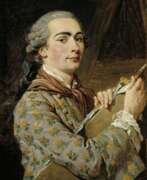

Louis Jean-François Lagrenée was a French painter and engraver, celebrated for his classical and mythological scenes that resonated with the Rococo and Neoclassical styles. Born in Paris in 1724, Lagrenée's artistic journey was significantly shaped by his time in Rome, funded by his 1749 Prix de Rome win. This period allowed him to immerse himself in the works of 17th-century Bolognese artists, notably influencing his style which later earned him the nickname 'the French Albani'.
Lagrenée's career featured prominent directorial roles at prestigious institutions such as the St Petersburg Academy and the Académie de France à Rome. His works were frequent highlights at the Paris Salon, reflecting his stature in the French art scene. Among his notable works are 'The Rape of Dejanira' and 'Mars and Venus, an Allegory of Peace', showcasing his mastery in portraying emotion and narrative through art.
His paintings are held in esteemed collections worldwide, including the Getty Center and the Musée national des châteaux de Versailles et de Trianon. Pieces like 'Pygmalion and Galatea' and 'Venus and Nymphs Bathing' demonstrate his skill in blending dramatic narratives with exquisite detail.
For those keen to explore the world of French classical painting and the works of Louis Jean-François Lagrenée, signing up for updates can enhance your appreciation and knowledge of this master's contributions to art history.


Johann Baptist Lampi the Younger was an Austrian portrait painter, renowned for his detailed and expressive portraiture. Born on March 4, 1775, in Trento, Lampi was educated at the Academy of Fine Arts Vienna under the guidance of Hubert Maurer and Heinrich Friedrich Füger. His artistic journey began under the tutelage of his father, Johann Baptist von Lampi the Elder, a prominent painter himself.
Lampi the Younger's career took a significant turn when he, along with his family, moved to St. Petersburg in 1797, following an invitation from Catherine the Great. This move marked a pivotal period in his life as he produced many portraits of Russian nobility and other significant figures of his time. His notable works during this period earned him a position as a member of the Academy in St. Petersburg and later in Vienna.
Among his well-known works, which can be viewed in major galleries such as the Belvedere Gallery and the Vienna Museum, are portraits of Antonio Canova, Francis I, and Ivan Akimov. His artistic legacy is further highlighted by his influence and contributions to the European art scene of the 19th century.
For enthusiasts and collectors interested in the works of Johann Baptist Lampi the Younger, signing up for updates can provide exclusive access to news about upcoming sales and auction events featuring his works. Ensure you stay informed about opportunities to acquire pieces by this distinguished artist.
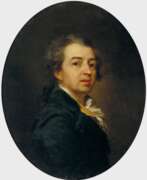

Dmitry Grigoryevich Levitzky (Russian: Дмитрий Григорьевич Левицкий) was an acclaimed Ukrainian-Russian portrait painter and academician born in May 1735, renowned for his exceptional contributions to the art of the 18th century. Originating from a family deeply rooted in the Ukrainian noble-priestly class, Levitzky's early exposure to art came from his father, Grigory Kirillovich Levitsky, a priest and an enthusiast in painting and engraving. This familial influence laid the foundation for Levitzky's artistic journey, which began in earnest when he assisted the prominent painter Alexey Antropov in Kiev, leading to his eventual move to Saint Petersburg.
Levitzky's rise to fame was marked by his unique ability to capture the essence of his subjects, combining exceptional technique with a fresh approach to portrait painting. His most notable works include portraits of significant figures from the Russian elite, such as Catherine II as the Legislatress in the Temple of the Goddess of Justice and portraits of the Smolny Institute's young ladies. Despite the grandeur and recognition that these works brought him, Levitzky faced financial struggles, spending his final years in poverty, a testament to the often-precarious nature of artistic acclaim.
His legacy, which had waned by the 19th century, was revitalized in the 20th century by art historian Alexander Benois, who positioned Levitzky among the pantheon of European Enlightenment artists. Levitzky's work is celebrated for its technical mastery and unique contribution to Russian and European portraiture, leaving an indelible mark on the artistic landscape of his time.
For collectors and experts in art and antiques, Levitzky's paintings are not just artistic achievements but also historical narratives captured in oil, reflecting the complex socio-cultural dynamics of 18th-century Russia. His portraits, housed in prestigious museums and galleries worldwide, continue to be studied and admired for their elegance, detail, and historical significance.
To stay updated on new findings and auction events related to Dmitry Grigoryevich Levitzky's works, sign up for updates. This subscription will ensure you're informed about sales and auctions where you can acquire pieces by this master portraitist, offering a unique opportunity to own a piece of art history.
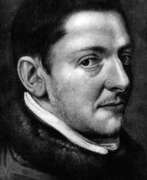

Anton Pavlovich Losenko (Russian: Антон Павлович Лосенко) was a Russian Neoclassical painter and academician of Ukrainian descent, celebrated for his historical subjects and portraits. Born in 1737 in Hlukhiv, Ukraine, and passing away in 1773 in Saint Petersburg, Russia, Losenko is recognized as a pivotal figure in the establishment of the Imperial Russian historical movement in painting. His education at the Imperial Academy of Arts and under Jean II Restout in Paris honed his skills, leading to masterpieces that blend Neoclassicism with humane narratives.
Losenko's legacy includes influential works such as the "Miraculous Catch of Fish" and the "Vladimir and Rogneda," reflecting his deep engagement with classical and biblical subjects as well as Russian history. This painter also contributed significantly to art education in Russia, authoring "Short Explanation of the Human Proportions," a textbook that educated generations of Russian artists. His students included notable names like Ivan Akimov, Grigory Ugrymov, and sculptor Mikhail Kozlovsky, indicating his lasting impact on Russian art.
His works, celebrated for their neoclassical style and emotional depth, are essential for understanding the evolution of Russian and European art. Losenko's role as a founder of Russian historical painting and his innovative approach to art education mark him as a key figure in art history. His paintings can be found in prominent museums and galleries, showcasing his significant contribution to the art world.
For collectors and experts in art and antiques, Losenko's work represents a fascinating intersection of Russian history, neoclassicism, and pedagogy in art. To stay updated on sales and auction events related to Losenko's works, signing up for updates can provide exclusive access to the latest information on this influential artist's pieces.
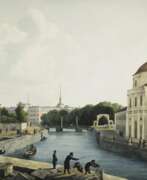

Andrey Efimovich Martynov (Russian: Андрей Ефимович Мартынов) was a Russian painter and engraver, known for his landscapes and lithographs. Born in 1768 in St. Petersburg, he graduated from the Imperial Academy of Arts in 1788. Martynov studied landscape painting under Semion Shchedrin and further honed his skills in Italy from 1788 to 1794, under the influence of Jakob Philipp Hackert. His Italian landscapes were highly appreciated upon his return to Russia, leading to his appointment as an academician in 1795.
Martynov’s work is renowned for its idealized and panoramic views of nature. He traveled extensively, capturing the beauty of rural Russia, Siberia, and Mongolia in his watercolors and lithographs. His series "Views of Russia and Mongolia" and "Peoples Types of Russia and Mongolia" are particularly admired for their detail and artistic quality. Martynov was also the official artist of the Russian embassy to China in 1805, a role that further enriched his portfolio with diverse cultural landscapes.
In addition to painting, Martynov contributed significantly to the development of lithography in Russia. His works, including scenes from the Crimea, the Baltic States, and the Volga River, are preserved in various museums, such as the Russian Museum and the Museum of the Academy of Fine Arts. Martynov’s legacy lies in his ability to blend classical composition with the celebration of natural beauty, making his works a valuable part of Russian art history.
To stay updated on new arrivals and auction events related to Andrey Efimovich Martynov, sign up for our updates. This subscription will only notify you about new product sales and auction events.
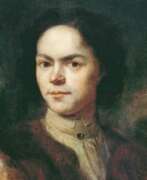

Andrey Matveevich Matveev (Russian: Андрей Матвеевич Матвеев) was a pioneering Russian portrait painter, instrumental in the development of secular painting in Russia during the 18th century. Born in 1701 in Novgorod, his early talent was recognized by Peter the Great, who sent him to Western Europe to study. Matveev spent eleven impactful years in the Netherlands and Flanders, honing his skills under notable artists like Carel de Moor before returning to Russia in 1727 as a highly skilled painter.
Matveev's contributions to Russian art were significant, as he became the first head of the Scenic team at the St. Petersburg Office of the Buildings, overseeing monumental and decorative art projects. His works include several portraits, such as the self-portrait with his wife, considered one of his most reproduced pieces, and the "Portrait of Peter I", both showcasing his refined European techniques and understated style.
Despite his relatively short life, passing away in 1739 at the age of 38, Matveev left a lasting impact on the Russian art scene, ushering in a new era of portraiture that moved away from the static figures of icon painting. His work is preserved in several major museums, including the Russian Museum in St. Petersburg, where his pioneering efforts continue to be celebrated.
For those interested in exploring more about Andrey Matveevich Matveev and his works, consider signing up for updates on new product sales and auction events related to his art. This subscription ensures that you stay informed about opportunities to own a piece of Russian art history.
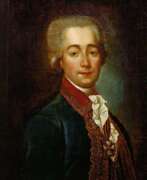

Leontiy Semenovich Miropolskiy (Russian: Леонтий Семёнович Миропольский) was a Russian painter, portraitist, copyist, and icon painter, prominent in the late 18th and early 19th centuries. He became an academician of the Imperial Academy of Arts after demonstrating his skills with a portrait of Gabriel Ignatievich Kozlov, an adjunct professor at the academy. His works include portraits that are highly individualized and closely resemble those of his teacher, Dmitry Levitsky.
Miropolskiy's contributions to Russian art extend beyond portraits; he was also an accomplished icon painter. He crafted icons for St. Andrew's Cathedral in Kronstadt, which, although the cathedral itself has since been destroyed, marks a significant part of his legacy in religious art. His paintings are housed in prestigious locations such as the State Russian Museum and the State Tretyakov Gallery, reflecting his lasting impact on Russian cultural heritage.
For art collectors and enthusiasts interested in exploring more about Miropolskiy's works or potential acquisition opportunities, consider signing up for updates related to his paintings. This subscription will keep you informed about new discoveries and auction events specifically tied to Miropolskiy's artistry.
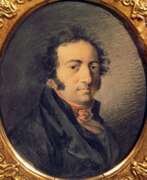

Alessandro Molinari was a German-born portrait painter of Italian ancestry, celebrated for his depictions of the Russian and Polish nobility. Born on January 5, 1772, in Berlin, and passing away on January 20, 1831, in Dresden, Molinari's artistic journey spanned various European locales. His prowess in portrait painting gained prominence during his stays in cities such as Rome, Vienna, and Saint Petersburg.
Molinari's technique and ability to capture the essence of aristocracy allowed him to become a favorite among the nobles during his time in Russia around 1806. His works often reflected a deep understanding of his subjects, infused with cultural insights that appealed to his high-society clientele. Notable pieces by Molinari include a miniature self-portrait circa 1820, showcasing his meticulous skill in this demanding medium. His legacy persists through his contributions to portrait painting, with his works displayed in prestigious institutions such as the Hermitage Museum and the Tretyakov Gallery.
For enthusiasts and collectors of classical portrait art, especially those focusing on European nobility, Alessandro Molinari's works offer a glimpse into the aristocratic life of the 18th and 19th centuries. To stay updated on exhibitions and auctions featuring Molinari's work, consider signing up for our newsletter. This subscription will keep you informed about new findings and sales directly related to Molinari, ensuring you never miss an opportunity to appreciate or acquire his timeless art.
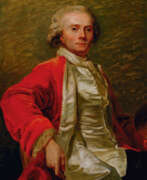

Jean-Laurent Mosnier was a French painter and miniaturist, renowned for his detailed and polished portraitures during the Ancien Régime. Born in Paris in 1743, Mosnier quickly ascended to become a court painter, notably serving Marie Antoinette. His mastery in miniature painting earned him significant acclaim, leading to a prosperous career across various European cities, including London, Hamburg, and St. Petersburg, after fleeing France due to the Revolution.
Mosnier's works are recognized for their exquisite attention to texture and fabric, skills likely honed during his early training at the Académie de Saint-Luc. He became a member of the Académie Royale in 1788, where his works, such as portraits of prominent academicians, solidified his reputation. His career spanned various shifts in his geographical and political contexts, adapting his artistic style to suit the tastes of his diverse clientele, including various European aristocrats and members of the Russian imperial family.
Several of Mosnier's significant works are housed in prestigious museums, including the Louvre and The Metropolitan Museum of Art, ensuring his legacy within the annals of European art history. For art collectors and enthusiasts interested in the rich history and exquisite craftsmanship of Jean-Laurent Mosnier's works, keeping updated on exhibitions and sales is invaluable. Sign up for updates on new product sales and auction events related to Jean-Laurent Mosnier to enhance your collection and appreciation of this distinguished artist.
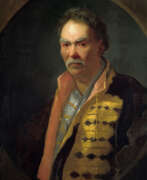

Ivan Nikitich Nikitin (Russian: Иван Никитич Никитин) was a Russian painter renowned for his masterful portraits and battle paintings, born around 1690 in Moscow into an Orthodox priest's family. His early exposure to art came from Dutch artist Schwonbek at the Kremlin Armoury engraving shop. Nikitin’s talent flourished under the patronage of Peter the Great, leading to his appointment as a court painter after educational stints in Florence and Venice.
Nikitin's artistry is marked by a transition from the rigid, dark background of the parsuna style to the vibrant and emotive tones of Baroque painting. His most celebrated works, often housed in major Russian museums like the Tretyakov Gallery and the Russian Museum, include portraits of significant historical figures such as Peter the Great and Count G. I. Golovkin. These works are praised for their psychological depth and the innovative use of light and shadow typical of the Baroque period.
Tragically, Nikitin’s career suffered a severe setback when he was imprisoned and later exiled due to political turmoil, although he was eventually pardoned. His life ended on a poignant note as he died in 1742 while returning to Saint Petersburg after his amnesty.
To receive updates on exhibitions and sales featuring Ivan Nikitich Nikitin's work, sign up for our newsletter. Stay informed about the latest opportunities to appreciate and acquire artwork from this master of Baroque painting.
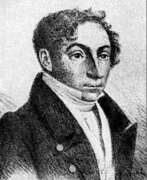

Józef Oleszkiewicz, a Polish-Lithuanian painter, was renowned for his contributions across Belarusian and Russian art scenes. Born in the late 18th century, Oleszkiewicz was celebrated for his masterful portraits and historical scenes, which were imbued with a distinctive blend of cultural influences that reflected his diverse heritage.
Oleszkiewicz's work is characterized by its meticulous detail and vibrant color palette, which set him apart from his contemporaries. His ability to capture the emotional depth and personality of his subjects made his portraits particularly revered. Among his notable works is the portrait of Adam Mickiewicz, a legendary figure in Polish literature, which is housed in the National Museum in Warsaw.
His career spanned various regions, leaving a significant mark on the art communities in Belarus and Russia as well. His influence is evident in the way he seamlessly integrated the artistic traditions of these cultures, making his works highly valuable not only for their aesthetic appeal but also for their cultural significance.
For collectors and experts in art and antiques, the work of Józef Oleszkiewicz offers a unique glimpse into the historical and cultural tapestry of Eastern Europe. His paintings are not just artistic expressions but are also historical documents that provide insight into the era's societal values and aesthetics.
To stay updated on exhibitions and auction events featuring works by Józef Oleszkiewicz, sign up for our newsletter. Ensure you never miss an opportunity to view or own a piece of this illustrious artist's legacy.
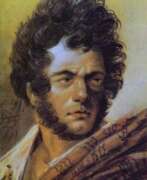

Aleksander Orłowski (Russian: Александр Осипович Орловский), a renowned Polish painter and sketch artist, was born on March 9, 1777, in Warsaw, within the Polish-Lithuanian Commonwealth. His journey into the arts began under challenging circumstances; he was the son of a tavern-keeper and his family was not wealthy. His early promise in art was nurtured by noble patron Izabela Czartoryska, who financed his initial education under the guidance of artist Jan Piotr Norblin.
Orłowski's artistic journey intersected with his military service during the Kościuszko Uprising, a major revolt against Imperial Russia and Prussia in 1794. This period of conflict significantly influenced his later works, which often depicted military scenes and the daily life of soldiers. After the partitions of Poland, Orłowski moved to Saint Petersburg in 1802, where he became a seminal figure in the development of lithography in the Russian Empire.
His oeuvre includes a wide array of subjects, from battle scenes to cultural depictions of everyday life in both Poland and Russia. Notable works such as "Battle Scene" and "Cossack Fighting Off A Tiger" showcase his skill in capturing dynamic movement and drama. His works are preserved in esteemed institutions such as The Russian Museum and The Tretyakov Gallery, highlighting their historical and artistic value.
Orłowski's impact extended beyond the canvas; he was also mentioned in literary works by notable authors like Adam Mickiewicz and Alexander Pushkin, which underscores his cultural significance in the 19th century.
For collectors and experts in art and antiques, Aleksander Orłowski's works represent a crucial segment of Eastern European art history. To stay informed about new discoveries or auction events related to his works, consider subscribing for updates. This subscription ensures you receive timely information tailored to your interests, directly relating to new sales and significant events around Orłowski's art.


Grigory Silovich Ostrovsky (Russian: Григорий Силович Островский) was an 18th-century Russian portrait painter, notable for his work in the Kostroma Governorate. Though much of his life remains shrouded in mystery, Ostrovsky is remembered for a collection of 17 signed and dated portraits discovered in the 1970s by art historian Savva Yamshchikov. These works, primarily painted in the 1770s and 1780s, were found at the Neronovo estate, associated with the Cherevin family.
Ostrovsky's artistic style suggests he may have been an itinerant painter and possibly received some training in icon painting. It is believed that he originated from Veliky Ustyug, a detail that adds to the enigmatic background of this artist. His works, including notable portraits such as those of Elizaveta Petrovna Cherevina and A. F. Catenin, are now housed in the Soligalich Regional Studies Museum in Soligalich.
For art enthusiasts and collectors, Ostrovsky’s works represent a fascinating facet of Russian portraiture, embodying the stylistic elements and cultural nuances of his time. To stay updated on exhibitions and sales featuring Grigory Silovich Ostrovsky’s works, sign up for our newsletter alerts specifically tailored for art collectors and connoisseurs.
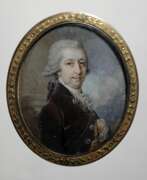

Augustin Christian Ritt was a Russian miniaturist born in 1765, known for his detailed and emotive portrait miniatures. Working primarily in the late 18th century, Ritt's artistry was distinguished by his ability to capture the nuances of his subjects' personalities in the confines of small ivory surfaces. His portraits often included prominent figures of Russian and European aristocracy, reflecting the social and cultural elite of his time.
Ritt's artworks, such as the portraits of Prince Alexei Borisovich Kurakin and Princess Natalia Iwanowna Kourakine, demonstrate his meticulous technique and his use of vibrant colors, which have made significant impacts on the art market. His pieces frequently fetch high prices at auctions, reflecting their historical value and the exquisite craftsmanship involved. For instance, his portrait of Prince Kurakin sold for a significant sum, highlighting the enduring demand for his work.
Collectors and experts in art and antiques appreciate Ritt's contribution to the field of miniature painting. His works are not only valuable for their artistic merit but also provide a window into the aesthetic preferences and cultural dynamics of his era. For updates related to new sales and auction events featuring Augustin Christian Ritt's works, sign up here. This subscription will keep you informed about opportunities to acquire pieces by this remarkable artist.


Fyodor Stepanovich Rokotov (Russian: Фёдор Степа́нович Ро́котов) was a distinguished Russian painter, celebrated for his profound contributions to the realm of portrait painting. Born into the 18th century, Rokotov emerged as a pivotal figure in Russian culture, art, and specifically in the development of Russian portrait painting. His ability to capture the essence of his subjects with both realism and sensitivity set a new standard in the art world, making him a beloved artist among collectors and experts alike.
Rokotov’s special features or merits lie in his exceptional skill in portraying the intricate nuances of the human face, coupled with his use of color and light to evoke a vivid presence of the subject. His works are known for their psychological depth and the dignified portrayal of his sitters, traits that have cemented his reputation as a master of portrait painting. Among his most renowned works, the portrait of Catherine II of Russia stands out as a testament to his skill and artistic vision.
Many of Rokotov's masterpieces grace the halls of prestigious museums and galleries, offering a glimpse into the rich cultural heritage of Russia. His paintings are not only significant for their aesthetic beauty but also for their historical value, providing insight into the social and cultural fabric of his time.
For collectors and art and antiques experts, the works of Fyodor Stepanovich Rokotov represent a valuable connection to the rich tapestry of Russian art history. His portraits are more than just depictions; they are windows into the soul of the 18th century, reflecting the elegance, complexity, and evolving culture of the period.
Stay abreast of the legacy of Fyodor Stepanovich Rokotov. Sign up for updates related to new product sales and auction events featuring the illustrious works of this iconic artist. Delve deeper into the world of art and antiques, and enrich your collection with pieces that speak volumes of history and sophistication. Subscribe now and ensure you never miss an opportunity to own a piece of Russian artistry.


Alexander Roslin was a distinguished Swedish portrait painter, celebrated for his refined depictions of European aristocracy, often highlighting his subjects' luxurious garments with great precision. Born in Malmö on July 15, 1718, Roslin moved to Paris in 1752 after developing his artistic skills in Sweden and traveling through Europe. His stay in Paris marked the peak of his career, where he became a prominent artist noted for his ability to capture the subtle intricacies of satin and skin, earning the admiration of high society.
Throughout his career, Roslin painted notable figures such as Empress Catherine II of Russia and members of the French aristocracy. His works, such as "The Lady with the Veil" (1768), showcase his skill in portraying delicate complexions and rich textiles, attributes that made his paintings highly sought after. This painting, along with others like "King Gustav III of Sweden" (1777), are celebrated for their artistic finesse and are held in prestigious collections, indicating Roslin's lasting legacy in the art world.
For collectors and enthusiasts of classical portraiture, Roslin's work offers a glimpse into the elegance of 18th-century aristocratic life, capturing both the opulence of the era and the personal character of his subjects. To stay updated on exhibitions and sales of Alexander Roslin's works, sign up for our newsletter. This subscription will keep you informed about new acquisitions and notable auction events featuring Roslin's art, ensuring you never miss an opportunity to appreciate or acquire his exquisite portraits.
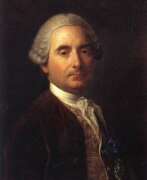

Pietro Antonio Rotari was an Italian painter born in Verona on September 30, 1707. His early artistic development was influenced by his studies under Antonio Balestra and later Francesco Trevisani and Francesco Solimena in Rome and Naples. Rotari's style evolved from history painting to focus primarily on portraitures, particularly of women, which garnered him significant acclaim.
Rotari's career spanned various European cities, with significant periods in Venice, Rome, and eventually Saint Petersburg, Russia, where he was invited by Empress Elizabeth in 1756 to become a court painter. His works are known for their emotional depth and the delicate portrayal of his subjects, often depicted in elegant, idealized manners that emphasized expressions of melancholy, surprise, or joy.
Many of Rotari's most celebrated works are portraits of young women in ethnic or regional costumes, displaying a range of subtle emotions. These works, often referred to as "character heads," are notable examples of his contribution to the rococo style, blending Italian artistry with international elements. His paintings are housed in several prominent collections, including the Cabinet of the Muses at Peterhof in Russia.
For those interested in the works and legacy of Pietro Antonio Rotari, particularly collectors and art historians, staying informed about exhibitions and auctions can enhance appreciation and opportunities to acquire his art. Sign up for updates on new sales and auction events featuring Rotari's works.
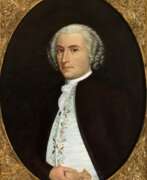

Francisco Salzillo y Alcaraz, a Spanish sculptor born in Murcia in 1707, was an iconic figure of the 18th century, particularly renowned for his Baroque style that beautifully transitioned into Rococo and Neoclassicism. The son of an Italian wood sculptor, Nicolás Salzillo, Francisco was deeply influenced by his father's craft and the local artistic milieu of Murcia. He became the most prominent member of his artistic family, taking over the family workshop at a young age and later establishing a small academy.
Salzillo's work is distinguished by its emotional depth and the naturalistic portrayal of religious themes, often in polychromed wood. Unlike his predecessors who focused on the drama of religious scenes, Salzillo explored naturalistic beauty, founding the Murcian School of Sculpture. His main works, such as "La Cena" (The Last Supper), "La Oración del Huerto" (The Agony in the Garden), and "El Prendimiento" (The Arrest), showcase his mastery in capturing serene beauty and human emotion. These pieces are celebrated for their expressive detail and the lifelike portrayal of biblical scenes.
The Salzillo Museum in Murcia houses his most representative works, including the famous "Bethlehem" and eight procession steps known as "Good Friday" pieces, among other significant iconographic models and sculptures. Salzillo's legacy lives on through these works, cementing his status as a master of color and form, and as a sculptor who blurred the lines between painting and sculpture.
For art collectors and enthusiasts interested in exploring the richness of Spanish Baroque art and Salzillo's contributions to it, signing up for updates related to Francisco Salzillo y Alcaraz can provide valuable insights into new product sales and auction events. This subscription offers a unique opportunity to stay connected with the world of an artist who played a pivotal role in the transition from Baroque to Rococo and Neoclassicism, ensuring enthusiasts don't miss out on acquiring pieces linked to this master sculptor's legacy.


Alexander Ivanovich Sauerweid (Russian: Александр Иванович Зауервейд) was a Baltic German painter born on February 19, 1783, in the Duchy of Courland and Semigallia. He is best known for his detailed battle scenes and military portraits, which earned him significant acclaim in the 19th century. His early education in the arts took place at the Dresden Academy of Fine Arts, where he developed a strong foundation in painting.
Sauerweid's talent for depicting military subjects brought him to the attention of prominent figures of his time, including Napoleon and Tsar Alexander I of Russia. Invited to Saint Petersburg in 1814, Sauerweid became the official painter of the Russian General Staff and later a professor at the St. Petersburg Imperial Academy of Arts. His role involved teaching battle painting and producing works that depicted various military uniforms and scenes, a specialty that set him apart from his contemporaries.
Among his notable works are "The Battle of Leipzig" and "The Siege of Varna," which showcase his ability to capture the dynamism and drama of military engagements. Many of Sauerweid's paintings are housed in Russian Imperial Palaces, reflecting their historical and artistic value.
For collectors and enthusiasts, keeping abreast of Alexander Ivanovich Sauerweid's works is essential. Subscribe to our updates to be the first to know about new product sales and auction events related to this distinguished artist. Sign up now!
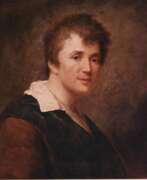

Stepan Semyonovich Shchukin (Russian: Степан Семёнович Щукин) was a distinguished Russian painter, celebrated for his refined portrait and watercolor artworks. Born in Moscow in 1754, Shchukin's artistic journey began under adverse circumstances, orphaned and admitted to the Orphan House in Moscow where he initially received his education.
Shchukin’s talent led him to the Imperial Academy of Arts, under the guidance of Dmitry Levitzky, one of the era's most esteemed Russian painters. His academic and artistic prowess earned him a scholarship to study further in Paris at the prestigious Académie de Peinture et de Sculpture, where he honed his skills with masters like Alexandre Roslin. Returning to Russia, Shchukin left a significant mark on the Russian art scene as a teacher at the Imperial Academy, influencing the next generation of artists including notable names like Alexander Varnek and Vasily Tropinin.
Among his notable works, Shchukin's portraits of eminent personalities like Emperor Paul I stand out. These portraits are not only masterpieces of art but also vital historical documents that capture the essence of an era. Shchukin's contributions to Russian art were profound, as he was integral in nurturing and shaping the aesthetic values of his time.
For collectors and experts in art and antiques, Shchukin's works represent a pivotal chapter in the evolution of Russian portraiture. His paintings, many of which are housed in prestigious galleries like the Russian Museum, continue to be studied and revered for their artistic and historical significance.
For updates on exhibitions and sales of Stepan Semyonovich Shchukin’s works, sign up for our newsletter. This subscription will keep you informed about the latest auction events and opportunities to acquire pieces by this illustrious artist.
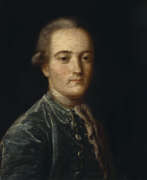

Mikhail Shibanov (Russian: Михаил Шибанов) was a Russian painter renowned for his contributions to the genre of portrait painting during the 1780s. His origins are humble; he was born into serfdom under the ownership of Prince Grigory Potemkin, with no definite records of his birth date available. Shibanov's artistic education took place at the Academy of Arts where he studied household painting from 1770 to 1780.
Shibanov's work primarily captured the life of peasants and Russian nobility through his realistic and genre paintings. Notably, he painted "Peasants' Meal" in 1774 and "The Celebration of the Wedding Agreement" in 1777. His mastery is exemplified in the portraits of significant historical figures, including the "Portrait of Count Alexander Dmitriev-Mamonov" from 1785, and the "Portrait of Empress Catherine II with Traveling Dress" created in 1787. These paintings are preserved in prominent Russian museums such as the Tretyakov Gallery and the Russian Museum.
Despite the limitations of his status and era, Shibanov's work left a lasting impression in Russian art history, embodying the characteristics of the Neoclassicism movement. His exact death date remains uncertain but is recognized as post-1798.
If you're captivated by the artistry and historical significance of Mikhail Shibanov, sign up for updates to stay informed about new findings, upcoming sales, and auction events featuring his work. This subscription ensures you remain connected to the fascinating world of Russian neoclassical art and Shibanov's lasting legacy. Subscribe today to enhance your collection and deepen your knowledge.
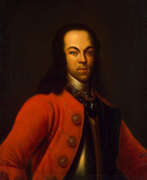

Johann Gottfried Tannauer was a German painter, portraitist, and miniaturist, renowned for his significant contributions to the art scene in Russia during the early 18th century. Born in 1680 in Saxony, Germany, Tannauer initially trained as a watchmaker and studied music before dedicating himself to painting. His artistic journey led him to Venice to study under Sebastiano Bombelli, and he also spent time in Holland, copying works by Rubens.
Invited to Russia by Peter the Great in 1710, Tannauer quickly rose to prominence within the Russian aristocracy, securing a role as a court painter. He was particularly appreciated for his ability to capture the essence and stature of his subjects, which included high-profile figures such as Tsar Peter I and his family. His artworks are notable for their dynamic Baroque style, characterized by intense color combinations and a sense of grandeur.
Several of Tannauer's works are preserved in prominent locations such as The Hermitage and the Russian Museum in St. Petersburg. His portraits are celebrated for their vivid portrayal and historical significance, offering a glimpse into the royal and noble personas of his time.
For those interested in exploring the works of Johann Gottfried Tannauer further, staying updated on exhibitions and sales can enrich your understanding of his impact on art history. You can sign up for updates related to Tannauer's artworks, ensuring you're informed about new insights and opportunities to view his masterpieces at auctions or exhibitions.
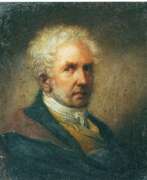

Salvatore Tonci was an Italian painter, musician, singer, and poet, renowned for his multifaceted artistic talents and his life largely spent in Russia. Born in January 1756 in Rome, Tonci moved to Russia in 1797, where he significantly contributed to the cultural scenes of St. Petersburg and Moscow until his death in December 1844. He was instrumental in the founding of the Architectural School in Moscow and is celebrated for his portrait paintings, which capture prominent figures of his time in a style that combines Italian finesse with Russian sensibilities.
Throughout his career, Tonci produced a series of notable works, including portraits of Russian Emperor Paul I and the poet Gavrila Derzhavin. His work is characterized by its historical depth and artistic mastery, reflecting the social and political landscapes of 18th and 19th century Russia. His contributions were not limited to painting; he also engaged in poetry and played a vital role in the artistic community as an educator, supervising drawing classes at the Moscow School of Painting, Sculpture and Architecture for over two decades.
For those interested in exploring the works of Salvatore Tonci or learning more about his contributions to art and culture, his paintings and other artistic expressions provide a fascinating glimpse into the rich cultural interchange between Italy and Russia during his lifetime. To stay updated on new discoveries and auction events related to Salvatore Tonci, you can sign up for updates, ensuring you don't miss out on any valuable insights or opportunities related to this remarkable artist.
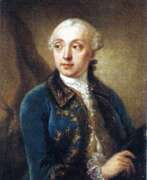

Stefano Torelli was an Italian painter, born in 1712 in Bologna. Renowned for his mastery in the Rococo style, Torelli initially trained under his father, Felice Torelli, and later under Francesco Solimena. His career flourished after being invited by Augustus III, the future King of Poland, to Dresden in 1740. There, he contributed significantly to decorating the royal palaces with altar-pieces, ceiling paintings, and collaborating with artists like Canaletto on views of Dresden.
Torelli's notable works include the "Portrait of Empress Catherine II" and the "Coronation of Catherine II", both reflecting his keen ability to blend opulence with intricate detail, a hallmark of the Rococo period. These works are celebrated for their artistic merit and are held in high esteem at institutions like The Russian Museum and The Tretyakov Gallery.
After his time in Dresden, Torelli was summoned to Russia in 1762, where he became a significant figure at the Russian court. His Russian period was marked by extensive contributions to palace decorations and portraits of royalty and nobility, enhancing his reputation and influence in the art world of his time.
For collectors and experts interested in Stefano Torelli's works, his paintings can be viewed at major museums, and reproductions are available for those wishing to own a piece inspired by his artistry. For updates on exhibitions and sales related to Stefano Torelli's works, signing up for dedicated newsletters can be a valuable resource.


Vasily Andreevich Tropinin (Russian: Василий Андреевич Тропинин) was a Russian Romantic painter, whose journey from serfdom to artistic freedom is as captivating as his art. Born in 1776, Vasily Tropinin spent a significant part of his life as a serf, only gaining freedom at the age of 47. His talent in painting, particularly in portraying intimate, personal, and "disheveled" portraits, earned him the nickname "a robe portraitist" among Muscovites.
Vasily Tropinin's works are celebrated for their deep analysis of the Russian national character and their reflection of the social types of his era. Notable works include "The Lace Maker," "Portrait of Alexander Pushkin," and portraits of everyday people, capturing the essence of Russian life with authenticity and emotional depth.
His contributions to Russian art did not go unnoticed, as he was awarded the title of "appointed academician" and later elected an Academician, reflecting his status as a respected artist of his time. Vasily Tropinin's legacy lives on, with more than 3,000 portraits credited to his name, and the Tropinin Museum in Moscow dedicated to his and his contemporaries' works.
For collectors and experts in art and antiques, Tropinin's paintings offer a unique window into 19th-century Russian life and culture. To stay informed about updates related to Vasily Andreevich Tropinin, including sales and auction events, consider signing up for updates, ensuring you remain connected to the rich heritage of Russian art.
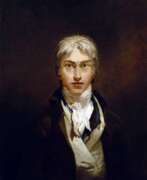

Joseph Mallord William Turner, a seminal figure in British painting, was born in 1775 and left an indelible mark on the Romantic movement. Known for his expressive coloration, imaginative landscapes, and turbulent marine paintings, Turner's work transcends the traditional boundaries of art to capture the sublime force of nature. His career was distinguished by early talent, evidenced by his acceptance into the Royal Academy at the young age of 14, and a prolific output that included over 2,000 paintings and 19,000 drawings and sketches.
William Turner's unique approach to landscape painting, characterized by dramatic skies and atmospheric effects, set a new standard for capturing mood and emotion on canvas. His innovative use of light and color influenced countless artists, elevating landscape painting to rival the status of history painting. Turner's legacy is also marked by his eccentricity and reclusiveness, traits that only added to the mystique surrounding his artistic genius.
Among his most famous works are "The Fighting Temeraire," symbolizing the passing of the old world, and "Rain, Steam and Speed," capturing the Industrial Revolution's impact. These paintings not only showcase William Turner's technical skill but also his philosophical engagement with the changing world around him.
For collectors and experts in art and antiques, William Turner's works represent the pinnacle of Romantic art, offering insight into the 19th-century aesthetic and philosophical landscape. His influence on subsequent generations of artists underscores his position as a pivotal figure in the history of Western art.
To stay informed about Joseph Mallord William Turner's works and related events, signing up for updates from reputable art institutions can provide valuable insights into new discoveries and auction events related to this master of the British landscape.
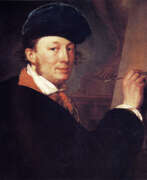

Alexander Gregoryevich Varnek (Russian: Александр Григорьевич Варнек) was a distinguished Russian painter. Known primarily for his portraits, Alexander Varnek captured the essence of figures in Russian society with a finesse that made him a notable artist of his time. He was a student under the guidance of Dmitry Levitzky and Stepan Shchukin at the Imperial Academy of Arts, where he later returned as a professor and advisor.
Alexander Varnek's artistry was celebrated for its masterful drawing, harmonious coloring, and the ability to capture close resemblances and appropriate lighting in his portraits. His conscientious execution and avoidance of embellishment in his works earned him high regard among contemporaries. Some of his notable works include portraits of Madame Khatova, Count Alexander Stroganov, and Alexey Olenin, along with other subjects like "Head of a Young Turk" and "Boy with Dog".
His life was intrinsically linked to St. Petersburg and the Imperial Academy of Arts, reflecting a career that spanned teaching, creating, and contributing significantly to Russian art. Alexander Varnek's journey included a period spent abroad in Rome, where he further honed his craft, leaving behind a legacy encapsulated in his portraits and other artworks that continue to be celebrated in the world of art.
For collectors and experts in art and antiques, Alexander Grigorievich Varnek's body of work offers a glimpse into the rich tapestry of Russian portraiture and its evolution during his lifetime. To delve deeper into his life and explore his creations, consider signing up for updates related to Varnek and stay informed about exhibitions, sales, and auctions of his works.
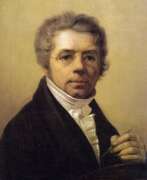

Alexei Gavrilovich Venetsianov (Russian: Алексей Гаврилович Венецианов), a pivotal figure in Russian art, is renowned for his dedication to portraying peasant life and everyday people. Born on February 7, 1780, in Moscow, Venetsianov's journey in art began in St. Petersburg, where, despite initially working as a draughtsman and land surveyor, he nurtured his artistic skills. His remarkable shift to painting was marked by his study at the Imperial Hermitage and under the mentorship of Vladimir Borovikovsky. In 1811, his talent was recognized with an Academician title by the Academy of Arts for his impressive works including a self-portrait.
Venetsianov's real artistic calling manifested in his portrayal of Russian peasant life. By the early 1820s, having moved to his estate in Safonkovo, he dedicated himself to genre art, painting scenes that reflected the everyday lives of peasants, a theme rarely explored in Russian art at the time. His works from this period, including "Beet-Picking" and "The Reaper," reveal a deep commitment to realistic authenticity. One of his notable works, "The Threshing Floor" (1821), housed in the Russian Museum, St. Petersburg, showcases his attention to detail and naturalistic approach. His art did not merely serve as a visual representation but also as a medium to celebrate the dignity and beauty inherent in peasant life, a stark contrast to the then-prevailing themes of aristocracy and nobility.
Throughout the 1820s and 1830s, Venetsianov's talent flourished, producing masterpieces like "Ploughing in Spring" and "Harvesting in Summer," both depicting the dignity of peasant labor in harmony with the Russian landscape. His works like "Sleeping Shepherd-Boy" (1823-26) are distinguished by their serene, poetic quality, blending human figures with nature seamlessly. His commitment to his art was so profound that he established a school for painting, guiding young artists, including those from impoverished backgrounds, fostering the Venetsianov school in Russian art.
Venetsianov's contribution to art was recognized and supported by Tsar Nicholas I, who appointed him a court painter, a role that facilitated his efforts in running his art school. Tragically, his life ended abruptly in an accident in 1847, but his legacy continues, with his works residing in esteemed collections like the Russian Museum and the Tretyakov Gallery.
For art collectors and experts, Venetsianov's works offer a unique glimpse into the soul of 19th-century Russian society, seen through the lens of its most humble members. His ability to capture the essence of peasant life with such dignity and beauty makes his artwork not only historically significant but also emotionally resonant. To stay informed about new product sales and auction events related to Alexei Gavrilovich Venetsianov, signing up for updates would be an enriching opportunity for those interested in his profound legacy.


Elisabeth Vigee Le Brun was a celebrated French painter, renowned for her skill in portrait painting during the late 18th and early 19th centuries. Born in Paris in 1755, Vigee Le Brun's artistic talent was evident from a young age, leading her to become one of the most successful female artists of her time. Her father, a portraitist himself, was a significant influence on her early artistic development.
Vigee Le Brun is perhaps best known for her association with Queen Marie Antoinette. She painted more than 30 portraits of the queen, capturing her in a light that combined personal intimacy with the regal dignity required of royal portraiture. Her ability to portray her subjects with both elegance and psychological depth won her acclaim and patronage from the highest ranks of society across Europe.
Her career spanned one of Europe's most turbulent periods, including the French Revolution, which forced her into exile. During her years abroad, she lived and worked in major cultural centers such as Rome, Vienna, and St. Petersburg, further cementing her reputation among European aristocracy.
Vigee Le Brun's works are displayed in prestigious museums worldwide, including the Metropolitan Museum of Art in New York and the Louvre in Paris. Her legacy is not only in her portraits but also in her memoirs, which provide a vivid account of the cultural atmosphere of her time and her encounters with various historical figures.
For updates related to Elisabeth Vigee Le Brun, including new product sales and auction events featuring her work, consider signing up for updates. This subscription ensures you are informed about the latest developments and opportunities to appreciate or acquire works by this influential artist.


Jean-Louis Voille was a French Rococo painter, renowned for his refined and delicate portraits, primarily painted during his time in Russia. Born in 1744 in Paris, Voille honed his artistic skills under the mentorship of François-Hubert Drouais at the Académie Royale. His journey as an artist took a pivotal turn when he moved to Saint Petersburg, where he became the court painter to Grand Duke Pavel Petrovich, the future Emperor Paul I of Russia.
Voille's art is celebrated for its serene and graceful portrayal of his subjects, capturing the elegance without the intrusion of strong emotions, which makes his works stand out with a distinctive calm and clarity. Among his notable works, several are housed in prestigious museums like the Hermitage in St. Petersburg, Russia. These include portraits such as "Woman in Blue" and his depiction of Ekaterina Stroganova as a child, which are considered key highlights of his career.
For those interested in the subtle beauty of Rococo art and Jean-Louis Voille's contribution to this era, staying informed about exhibitions and auction events can provide unique insights and opportunities to appreciate his work more deeply. To receive updates related to Jean-Louis Voille, including new product sales and auction events, sign up. This subscription is designed specifically for collectors and experts in art and antiques, focusing solely on relevant and curated content.


Johann Karl Ferdinand von Kügelgen was a German landscape and history painter, known for his work as a Russian court painter and his contributions to both the Imperial Academy of Arts in St. Petersburg and the Prussian Academy of Arts in Berlin. Born on February 6, 1772, in Bacharach am Rhein, Kügelgen's artistic journey took him across Europe, where he honed his skills in various cities including Frankfurt, Würzburg, and Rome.
Kügelgen's paintings are celebrated for their transparency and ethereal color palette, often reflecting the natural landscapes he was deeply inspired by. His notable works include over 200 landscapes and depictions of ancient monuments, particularly from his travels to Crimea under the commission of Tsar Alexander I. These works are highly valued for their historical and artistic significance, capturing the essence of the regions he explored.
During his career, Kügelgen faced many challenges, including financial difficulties and the turmoil of the Napoleonic Wars, which forced him and his family to flee to Wolsk. Despite these hardships, he continued to produce art and teach, leaving a lasting legacy through his works and his influence on future generations, including his son Konstantin von Kügelgen, who also became a renowned landscape painter.
If you are an art collector or enthusiast, sign up for updates on upcoming sales and auction events related to Johann Karl Ferdinand von Kügelgen. Stay informed about new opportunities to acquire pieces of his remarkable legacy.
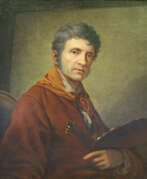

Johann Baptist von Lampi was an Austrian-Italian portrait painter renowned for his influential style and significant contributions to the art world. Born in 1751 in Romeno, Tyrol, Lampi’s career took a pivotal turn when he moved to St. Petersburg in 1791. There, he received a hereditary knighthood from the Empress and became a sought-after portraitist, painting notable figures including Empress Catherine II and Maria Feodorovna.
Lampi’s work is characterized by its vivid realism and meticulous attention to detail, qualities that made him a favorite in the Russian court and later in Vienna, where he returned in 1797. His portraits, often rich in texture and color, capture the essence of his subjects with striking clarity. Notable works include portraits of King Stanisław II August and Countess Zavadskaya, displayed in major museums like the National Museum in Warsaw and the Łazienki Palace.
For those interested in exploring Lampi’s legacy further or acquiring pieces associated with him, staying informed about upcoming sales and exhibitions is essential. Sign up for updates to ensure you don't miss out on important auction events related to Johann Baptist von Lampi’s works.
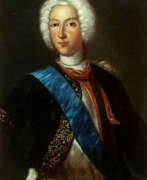

Johann Heinrich Wedekind was a Baltic-German painter born on August 15, 1674, in Reval (now Tallinn, Estonia) and died on October 8, 1736, in Saint Petersburg, Russia. He is noted for his contributions to secular portrait painting in Russia, particularly during the era of Peter the Great, whom he served as a court painter. Wedekind's work helped establish the genre of secular portraiture in Russia, a significant departure from the predominantly religious themes that characterized Russian art at the time.
Wedekind initially trained under the Baltic-German painter Ernst Wilhelm Londicer and spent significant periods working in Lübeck and Riga before relocating permanently to Russia. Throughout his career, he painted many notable figures, including Swedish and Russian nobility and royalty such as King Charles XII of Sweden and Tsar Peter the Great. Many of his works are held in private collections, with some attributed based on his distinctive brush technique, though they were widely dispersed following the October Revolution.
Despite his contributions to Russian art, critical reviews of Wedekind's work tend to describe it as diligent yet mediocre. His life outside of painting was marked by personal responsibilities, including managing a family pharmacy, which might have affected his artistic output. Today, while many of his paintings are no longer in major museums, his legacy as a pioneer of portrait painting in Russia endures.
For updates related to Johann Heinrich Wedekind, including new product sales and auction events featuring his works, sign up for our specialized alerts here. This subscription ensures you stay informed about opportunities to acquire pieces by this historical artist.
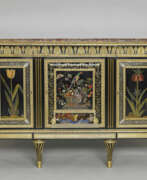

Adam Weisweiler was a distinguished French cabinetmaker, renowned for his exceptional creations that resonated deeply with the culture and art of his time. Originating from Germany, Weisweiler moved to Paris, where he became an emblematic figure in the realm of fine furniture making during the late 18th century. His specialization in crafting exquisite pieces, often adorned with intricate marquetry and mounted with elegant bronzes, set new standards in the world of decorative arts.
Weisweiler's work is celebrated for its refined elegance and the harmonious blend of functionality with aesthetic appeal. His ability to incorporate elements of sculpture and painting into his furniture designs elevated the pieces from mere objects of utility to cherished works of art. The meticulous attention to detail and the innovative use of materials like ebony and mahogany, coupled with his mastery over the classical motifs, made his creations highly sought after by the aristocracy and collectors alike.
Several of Adam Weisweiler's masterpieces find their homes in prestigious museums and galleries around the world, serving as testaments to his enduring legacy in the art and antiques sphere. His contributions to the field have not only enriched the cultural heritage of France but have also left an indelible mark on the global appreciation of fine antique furniture.
For collectors and experts in art and antiques, Adam Weisweiler's work represents the pinnacle of craftsmanship and artistic vision. His creations continue to inspire and captivate, embodying the quintessence of French decorative arts. To stay informed about new product sales and auction events related to Adam Weisweiler, we invite you to sign up for updates. This subscription ensures you are always in the know, without any unwelcome intrusions, focusing solely on opportunities to acquire pieces linked to this illustrious artist's legacy.
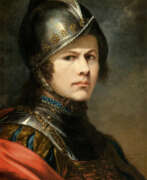

Feodosy Ivanovich Yanenko (Russian: Феодосий Иванович Яненко) was a Russian artist born in 1762 and notable for his contributions to religious and portrait painting. Trained at the Imperial Academy of Arts under Gabriel Ignatievich Kozlov, Yanenko's talent was recognized early in his career. In 1795, he was assigned to the Academy for his studies of the naked human figure, and by 1797, his painting "Travellers in a Storm" earned him the rank of academician.
Yanenko is best known for his religious artworks, including several images for the Kazan Cathedral in St. Petersburg. His prowess in portrait painting is exemplified by his work housed in the Tretyakov Gallery, Moscow—a portrait of Emperor Paul I when he was Crown Prince, painted in 1798.
His works are cherished for their historical significance and artistic quality, making them of great interest to collectors and art historians alike. For those passionate about Russian art from the late 18th century, Yanenko's contributions remain an essential part of the discussion.
For updates related to new product sales and auction events featuring Feodosiy Ivanovich Yanenko's works, consider signing up for our newsletter. This subscription will keep you informed about all the latest developments and opportunities to acquire pieces by this distinguished artist.


Alexei Yegorovich Yegorov (Russian: Алексей Егорович Егоров) was a renowned Russian painter, draftsman, and professor of history painting. Known for his work in monumental and religious painting, Yegorov's journey in the arts began under challenging circumstances as he was captured by Cossacks in his childhood and placed in a Moscow orphanage. His talent was recognized early on, leading to his education at the Imperial Academy of Arts in St. Petersburg, where he studied under esteemed professors and earned multiple awards for his exceptional skills.
Alexei Yegorov's career blossomed further during his stay in Rome from 1803 to 1807, where he was influenced by and collaborated with prominent artists of the time. His works gained significant recognition, earning him the affectionate nickname "Russian Bear" for his formidable stature and exceptional artistic talents. Despite an offer to stay in Italy as a court painter by Pope Pius VII, Yegorov chose to return to Russia, where he achieved notable success as an academician and a professor at the Imperial Academy of Arts.
His contributions to Russian art are vast, encompassing religious and historical themes. Yegorov's works include paintings for the Kazan Cathedral, the Tauride Palace, and various other significant locations. His mastery in drawing was particularly praised, with a style marked by elegance and expressiveness. Despite facing dismissal from the academy later in his career due to the displeasure of Emperor Nicholas I, Yegorov continued to influence the Russian art scene, advising young artists and working on his projects until his last days.
For collectors and art experts, Alexei Yegorov's legacy offers a deep well of Russian classicism and academic art to explore. His works, residing in museums like the State Russian Museum and the Tretyakov Gallery, continue to inspire and captivate audiences, showcasing the depth and breadth of his artistic prowess.
If you're intrigued by the life and works of Alexei Yegorovich Yegorov and wish to stay informed about related updates, consider subscribing for notifications on new findings, sales, and auction events concerning his artworks.
